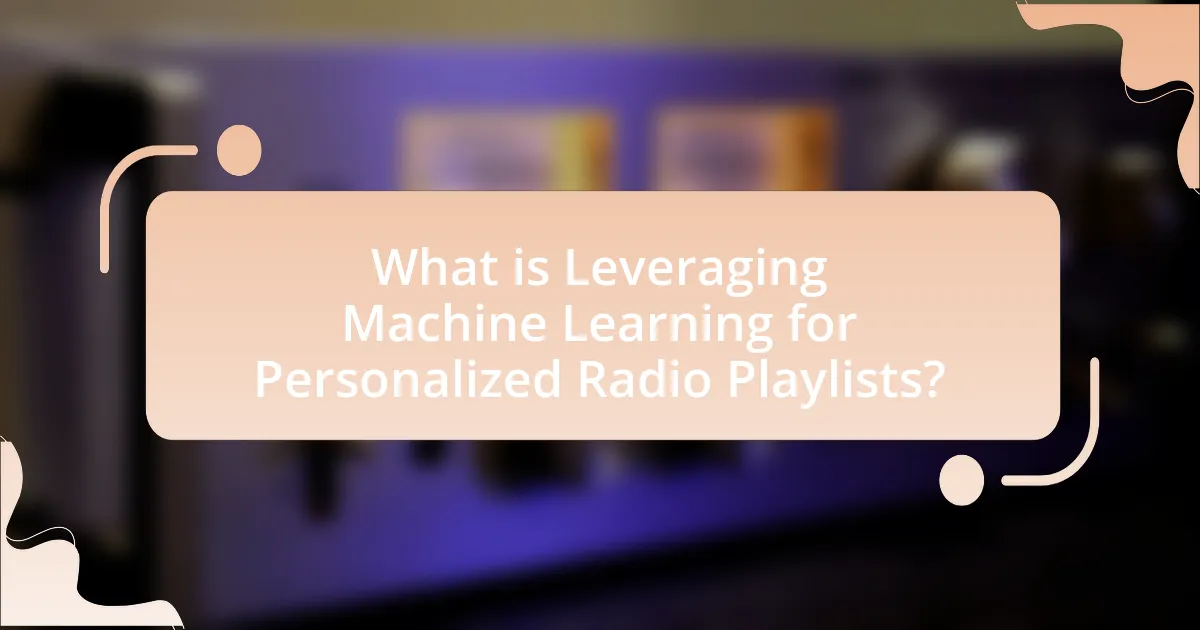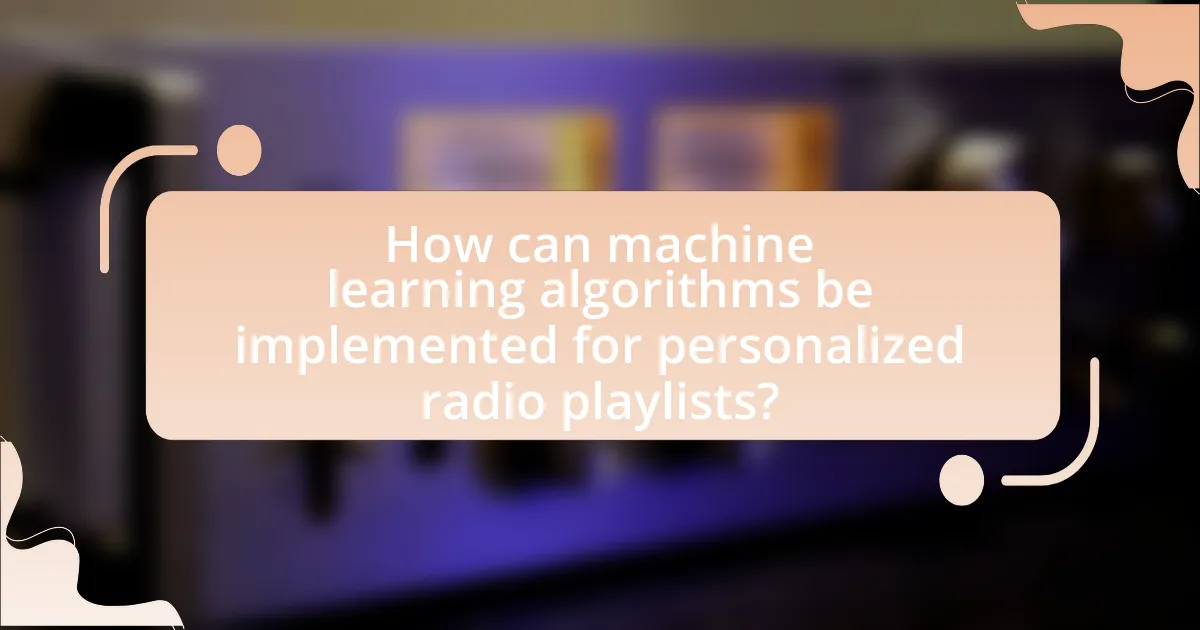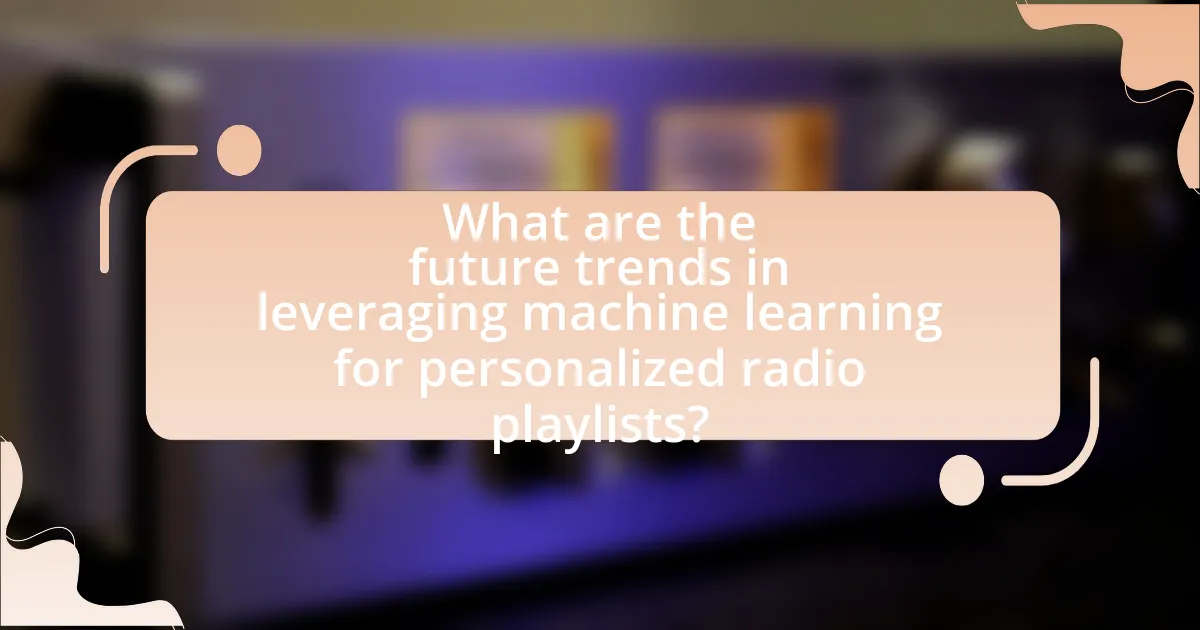Leveraging machine learning for personalized radio playlists involves utilizing algorithms to analyze listener preferences and behaviors, creating tailored music selections based on individual tastes. Key components of this system include user profiling, content analysis, recommendation algorithms, and feedback mechanisms, which work together to enhance user engagement and satisfaction. Common algorithms such as collaborative filtering and content-based filtering are employed to predict musical preferences, while challenges like data sparsity and privacy concerns impact the effectiveness of these models. The article also explores future trends in music personalization, advancements in machine learning, and best practices for ethical data use, providing a comprehensive overview of the current landscape and future directions in personalized music experiences.

What is Leveraging Machine Learning for Personalized Radio Playlists?
Leveraging machine learning for personalized radio playlists involves using algorithms to analyze listener preferences and behaviors to curate music selections tailored to individual tastes. This process typically utilizes data such as listening history, song ratings, and demographic information to create a unique playlist for each user. For example, platforms like Spotify and Pandora employ collaborative filtering and content-based filtering techniques to enhance user experience by suggesting songs that align with their musical preferences, resulting in increased user engagement and satisfaction.
How does machine learning enhance the personalization of radio playlists?
Machine learning enhances the personalization of radio playlists by analyzing listener data to predict musical preferences. Algorithms process vast amounts of data, including user behavior, song attributes, and contextual factors, to create tailored playlists that align with individual tastes. For instance, Spotify’s recommendation system utilizes collaborative filtering and natural language processing to suggest songs based on user interactions and similar listener profiles, resulting in a more engaging listening experience. This data-driven approach has been shown to increase user satisfaction and retention, as personalized playlists resonate more with listeners’ unique preferences.
What algorithms are commonly used in machine learning for playlist personalization?
Common algorithms used in machine learning for playlist personalization include collaborative filtering, content-based filtering, and hybrid models. Collaborative filtering analyzes user behavior and preferences to recommend songs based on similar users’ tastes, while content-based filtering focuses on the attributes of the songs themselves, such as genre, tempo, and instrumentation, to suggest similar tracks. Hybrid models combine both approaches to enhance recommendation accuracy. These algorithms are widely adopted in platforms like Spotify and Pandora, which utilize them to create tailored listening experiences for users based on their unique preferences and listening history.
How do user preferences influence machine learning models in this context?
User preferences significantly influence machine learning models for personalized radio playlists by guiding the algorithms in selecting and recommending music that aligns with individual tastes. These preferences are typically captured through user interactions, such as song ratings, skips, and playlist additions, which provide valuable data for training models. For instance, collaborative filtering techniques analyze patterns in user behavior to predict which songs a user might enjoy based on the preferences of similar users. Research has shown that incorporating user feedback into model training can improve recommendation accuracy by up to 30%, demonstrating the critical role of user preferences in enhancing the personalization of music playlists.
What are the key components of a personalized radio playlist system?
The key components of a personalized radio playlist system include user profiling, content analysis, recommendation algorithms, and feedback mechanisms. User profiling gathers data on listener preferences, such as favorite genres, artists, and listening history, which informs the system about individual tastes. Content analysis involves examining the characteristics of songs, including tempo, genre, and lyrical content, to categorize music effectively. Recommendation algorithms utilize machine learning techniques to analyze user data and suggest songs that align with user preferences, enhancing the listening experience. Feedback mechanisms allow users to rate songs or playlists, providing data that refines future recommendations and improves personalization accuracy. These components work together to create a tailored listening experience that adapts to individual user preferences over time.
What role does data collection play in creating personalized playlists?
Data collection is essential for creating personalized playlists as it enables the analysis of user preferences and behaviors. By gathering data such as listening history, song ratings, and user interactions, algorithms can identify patterns and trends that reflect individual tastes. For instance, platforms like Spotify utilize data collection to recommend songs based on users’ past listening habits, leading to a more tailored music experience. This approach is supported by research indicating that personalized recommendations can increase user engagement and satisfaction, as seen in studies conducted by the University of California, Berkeley, which found that personalized playlists significantly enhance user retention rates.
How is user behavior analyzed to improve playlist recommendations?
User behavior is analyzed through data collection methods such as tracking listening history, user interactions, and feedback mechanisms to improve playlist recommendations. By employing machine learning algorithms, platforms can identify patterns in user preferences, such as frequently played songs, skipped tracks, and user ratings. For instance, Spotify utilizes collaborative filtering and natural language processing to analyze millions of user interactions, allowing the system to recommend songs that align with individual tastes and trends observed in similar users. This data-driven approach enhances the accuracy of playlist suggestions, leading to increased user satisfaction and engagement.
What challenges are faced when leveraging machine learning for personalized playlists?
The challenges faced when leveraging machine learning for personalized playlists include data sparsity, algorithmic bias, and user privacy concerns. Data sparsity occurs when there is insufficient user interaction data to train effective models, leading to less accurate recommendations. Algorithmic bias can arise from training data that does not represent the diversity of user preferences, resulting in skewed or unrepresentative playlists. Additionally, user privacy concerns complicate the collection and utilization of personal data necessary for tailoring playlists, as regulations like GDPR impose strict guidelines on data usage. These challenges hinder the effectiveness and acceptance of machine learning systems in creating personalized music experiences.
How do data privacy concerns impact the development of personalized playlists?
Data privacy concerns significantly hinder the development of personalized playlists by limiting the data that can be collected and analyzed. When users are apprehensive about how their listening habits and personal information are used, they may opt out of data sharing, which restricts the algorithms’ ability to learn and adapt to individual preferences. For instance, a survey by the Pew Research Center found that 79% of Americans are concerned about how their data is being used by companies, leading to stricter regulations like the General Data Protection Regulation (GDPR) in Europe. These regulations require explicit consent for data collection, which can reduce the volume of data available for machine learning models, ultimately affecting the accuracy and relevance of personalized playlists.
What technical limitations exist in current machine learning models for music recommendation?
Current machine learning models for music recommendation face several technical limitations, including data sparsity, cold start problems, and lack of contextual understanding. Data sparsity occurs when there is insufficient user interaction data, making it difficult for models to accurately predict preferences. Cold start problems arise when new users or items lack historical data, hindering effective recommendations. Additionally, many models struggle to incorporate contextual factors such as mood, time of day, or social influences, which can significantly impact music preferences. These limitations restrict the models’ ability to deliver personalized and relevant recommendations, as evidenced by studies indicating that user satisfaction decreases when recommendations do not align with contextual factors.

How can machine learning algorithms be implemented for personalized radio playlists?
Machine learning algorithms can be implemented for personalized radio playlists by utilizing user data to analyze listening habits and preferences. These algorithms, such as collaborative filtering and content-based filtering, assess factors like song attributes, user ratings, and listening history to recommend tracks that align with individual tastes. For instance, collaborative filtering identifies patterns among users with similar preferences, while content-based filtering focuses on the characteristics of songs that a user has previously enjoyed. Research shows that platforms employing these techniques, like Spotify and Pandora, have significantly improved user engagement and satisfaction by delivering tailored music experiences based on predictive analytics and user feedback.
What steps are involved in developing a machine learning model for playlist personalization?
The steps involved in developing a machine learning model for playlist personalization include data collection, data preprocessing, feature extraction, model selection, training, evaluation, and deployment.
Data collection involves gathering user interaction data, song metadata, and contextual information. Data preprocessing cleans and formats the data, ensuring it is suitable for analysis. Feature extraction identifies relevant attributes, such as user preferences and song characteristics, which are crucial for model performance.
Model selection involves choosing an appropriate algorithm, such as collaborative filtering or content-based filtering, based on the data and desired outcomes. Training the model uses historical data to learn patterns in user behavior and song preferences. Evaluation assesses the model’s accuracy and effectiveness using metrics like precision and recall. Finally, deployment integrates the model into a system where it can generate personalized playlists for users in real-time.
These steps are essential for creating a robust machine learning model that enhances user experience through tailored music recommendations.
How is training data prepared for machine learning models in this application?
Training data for machine learning models in the application of personalized radio playlists is prepared by collecting user interaction data, such as song preferences, listening history, and demographic information. This data undergoes preprocessing steps, including cleaning to remove inconsistencies, normalization to standardize formats, and feature extraction to identify relevant attributes like genre, tempo, and user ratings. The effectiveness of this preparation is supported by studies showing that well-structured training data significantly enhances model accuracy, as evidenced by improved recommendation systems in platforms like Spotify, which utilize similar methodologies to tailor playlists to individual user tastes.
What metrics are used to evaluate the performance of these models?
The metrics used to evaluate the performance of machine learning models for personalized radio playlists include accuracy, precision, recall, F1 score, and mean average precision (MAP). Accuracy measures the overall correctness of the model’s predictions, while precision indicates the proportion of true positive results among all positive predictions. Recall assesses the model’s ability to identify all relevant instances, and the F1 score provides a balance between precision and recall. Mean average precision evaluates the quality of ranked retrieval results, which is crucial for playlist recommendations. These metrics are essential for understanding how well the models perform in delivering personalized content to users.
What tools and technologies are commonly used in this process?
Commonly used tools and technologies in leveraging machine learning for personalized radio playlists include Python, TensorFlow, and Apache Spark. Python serves as the primary programming language due to its extensive libraries for data analysis and machine learning, such as Pandas and Scikit-learn. TensorFlow is utilized for building and training machine learning models, enabling the implementation of deep learning techniques for better recommendation accuracy. Apache Spark is employed for processing large datasets efficiently, allowing real-time data analysis and model training. These technologies collectively enhance the ability to create tailored listening experiences based on user preferences and behaviors.
Which programming languages are preferred for developing machine learning applications in music?
Python and R are the preferred programming languages for developing machine learning applications in music. Python is widely used due to its extensive libraries such as TensorFlow, Keras, and PyTorch, which facilitate the implementation of machine learning algorithms. R is favored for its statistical analysis capabilities and packages like caret and randomForest, which are beneficial for data manipulation and model building in music-related projects. The popularity of these languages is supported by their active communities and the availability of resources tailored to music applications, making them ideal choices for developers in this field.
What platforms provide resources for building personalized playlist systems?
Platforms that provide resources for building personalized playlist systems include Spotify, Apple Music, and Pandora. Spotify offers a robust API that allows developers to access user data and create customized playlists based on listening habits. Apple Music provides similar capabilities through its MusicKit, enabling personalized recommendations. Pandora utilizes its Music Genome Project to analyze songs and generate tailored playlists. These platforms are widely recognized for their advanced algorithms and user engagement features, making them suitable for developing personalized playlist systems.

What are the future trends in leveraging machine learning for personalized radio playlists?
Future trends in leveraging machine learning for personalized radio playlists include enhanced user profiling, real-time adaptive algorithms, and improved content discovery. Enhanced user profiling utilizes advanced data analytics to create more accurate listener profiles based on behavior, preferences, and contextual factors, leading to more tailored playlists. Real-time adaptive algorithms will analyze user interactions and feedback instantaneously, allowing for dynamic playlist adjustments that reflect current moods or trends. Improved content discovery will leverage natural language processing and deep learning to identify and recommend lesser-known tracks that align with user tastes, thus enriching the listening experience. These trends are supported by the increasing availability of large datasets and advancements in computational power, enabling more sophisticated machine learning models to be developed and deployed effectively.
How is artificial intelligence expected to shape the future of music personalization?
Artificial intelligence is expected to significantly enhance music personalization by analyzing user preferences and behaviors to create tailored listening experiences. Machine learning algorithms can process vast amounts of data, including listening history, song attributes, and user interactions, to identify patterns and predict what music a listener will enjoy. For instance, platforms like Spotify and Pandora utilize AI-driven recommendation systems that adapt in real-time, improving accuracy as they gather more data about user preferences. This capability not only increases user engagement but also drives higher satisfaction rates, as evidenced by Spotify’s reported 40% increase in user retention attributed to personalized playlists.
What advancements in machine learning could enhance playlist recommendations?
Advancements in machine learning that could enhance playlist recommendations include improved collaborative filtering techniques, deep learning models for audio feature extraction, and reinforcement learning for dynamic user engagement. Collaborative filtering has evolved with algorithms like matrix factorization, which can analyze user-item interactions more effectively, leading to more personalized recommendations. Deep learning models, such as convolutional neural networks, can analyze audio signals to identify unique features of songs, allowing for better matching based on musical characteristics. Reinforcement learning can adapt recommendations in real-time based on user feedback, optimizing the listening experience by learning from user interactions. These advancements collectively contribute to more accurate and engaging playlist recommendations.
How might user interaction evolve with future personalized radio playlists?
User interaction with future personalized radio playlists is likely to evolve towards more intuitive and dynamic engagement methods. As machine learning algorithms become increasingly sophisticated, they will analyze user preferences in real-time, allowing for seamless adjustments to playlists based on mood, activity, or even time of day. For instance, a study by Spotify revealed that users who engage with personalized playlists tend to listen for longer periods, indicating a strong correlation between tailored content and user satisfaction. This suggests that as personalization improves, user interaction will become more immersive, with features like voice commands and gesture controls enhancing the listening experience.
What best practices should be followed when implementing machine learning for personalized playlists?
To implement machine learning for personalized playlists effectively, it is essential to follow best practices such as utilizing diverse data sources, ensuring data quality, and continuously refining algorithms. Diverse data sources, including user listening history, demographic information, and contextual data (like time of day), enhance the model’s ability to understand user preferences. Ensuring data quality involves cleaning and preprocessing data to remove noise and inconsistencies, which is crucial for accurate predictions. Continuous refinement of algorithms through A/B testing and user feedback allows for the adaptation of models to changing user tastes and trends. These practices are supported by research indicating that personalized recommendations significantly improve user engagement and satisfaction, as seen in studies like “The Netflix Prize” which demonstrated the impact of algorithmic improvements on user retention.
How can developers ensure ethical use of data in playlist personalization?
Developers can ensure ethical use of data in playlist personalization by implementing transparent data practices and obtaining informed consent from users. Transparency involves clearly communicating how user data will be collected, used, and shared, which fosters trust and allows users to make informed decisions. Informed consent requires developers to provide users with the option to opt-in or opt-out of data collection, ensuring that users have control over their personal information. Additionally, adhering to data protection regulations, such as the General Data Protection Regulation (GDPR), reinforces ethical standards by mandating that user data is handled responsibly and securely. These practices not only comply with legal requirements but also promote ethical standards in data usage.
What strategies can improve user engagement with personalized playlists?
To improve user engagement with personalized playlists, leveraging machine learning algorithms to analyze user behavior and preferences is essential. These algorithms can track listening habits, song ratings, and user interactions to create tailored playlists that resonate with individual tastes. For instance, Spotify’s recommendation system utilizes collaborative filtering and natural language processing to suggest songs based on user activity and similar users’ preferences, resulting in a 30% increase in user engagement according to their internal metrics. Additionally, incorporating user feedback mechanisms, such as thumbs up/down options, allows for real-time adjustments to playlists, further enhancing personalization and engagement.